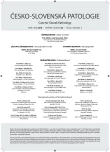-
Medical journals
- Career
Postinfectious glomerulonephritis in adults: a hidden face of an old disease
Authors: Eva Honsová
Authors‘ workplace: Pracoviště klinické a transplantační patologie, Transplantcentrum IKEM, Praha
Published in: Čes.-slov. Patol., 52, 2016, No. 1, p. 61-64
Category: Reviews Article
Overview
The epidemiology of postinfectious GN has changed considerably during recent decades, especially in developed countries. This disease typically has occurred in children and most often following a respiratory tract or skin infection with streptococcus. There is a decline in the prevalence of the disease in childhood, whereas the significant proportion of cases afflicts adults, mainly the elderly. Currently, the affected patients in developed countries are more often elderly, especially those with co-morbidities such as diabetes and alcoholism. The bacteriology of adult postinfectious GN also differs from the typical childhood disease. Staphylococci have become more common than Streptococci in elderly patients. The morphological features are also different, there is predominantly IgA positive staining and the disease is called IgA-dominant postinfectious GN. It is important to be aware of this shifting behavior of postinfectious GN, because adult patients and mainly the elderly are at a higher risk for a poor renal outcome.
Keywords:
postinfectious GN – IgA dominant PIGN – elderly
Sources
1. Kanjanabuch T, Kittikowit W, Eiam-Ong S. An update on acute postinfectious glomerulonephritis worldwide. Nat Rev Nephrol 2009; 5 : 259-269.
2. Thongboonkerd V, Luengpailin J, Cao J, et al. Fluoride exposure attenuates of Streptococcus pyogenes virulence factors. J Biol Chem 2002; 277 : 16599-16605.
3. Nasr SH, Radhakrishnan J, D‘Agati VD. Bacterial infection-related glomerulonephritis in adults. Kidney Int 2013; 83 : 792-803.
4. Nast CC. Infection-related glomerulonephritis: changing demographics and outcomes. Adv Chronic Kidney Dis 2012; 19 : 68-75.
5. Nadasdy T, Hebert LA. Infection-related glomerulonephritis: understanding mechanisms. Semin Nephrol 2011; 31 : 369-375.
6. Sethi S, Fervenza FC, Zhang Y, et al. Atypical postinfectious glomerulonephritis is associated with abnormalities in the alternative pathway of complement. Kidney Int 2013; 83 : 293-299.
7. Nasr SH, Fidler ME, Valeri AM et al. Postinfectious glomerulonefritis in the elderly. J Am Soc Nephrol 2011; 22 : 187-195.
8. Nasr SH, D‘Agati VD. IgA-dominant postinfectious glomerulonephritis: a new twist on an old disease. Nephron Clin Pract 2011; 119: c18-c25.
9. Kambham N. Postinfectious glomerulonephritis. Adv Anat Pathol 2012; 19 : 338-347.
Labels
Anatomical pathology Forensic medical examiner Toxicology
Article was published inCzecho-Slovak Pathology

2016 Issue 1-
All articles in this issue
- Skin cell response after jellyfish sting
- Postinfectious glomerulonephritis in adults: a hidden face of an old disease
- Serrated adenomas and carcinomas of the colon
- Morphology of the gastroesophageal reflux disease
- Pathology of non-reflux esophagitides
- Follicular and mantle cell lymphoma diagnosed in biopsies of gastroenterocolic region
- Hypoglycemia in a solitary fibrous tumor of the liver
- Clinicopathological correlations of the immunoprofile in diffuse large B-cell lymphoma NOS - a single institution’s experience
- Czecho-Slovak Pathology
- Journal archive
- Current issue
- Online only
- About the journal
Most read in this issue- Serrated adenomas and carcinomas of the colon
- Morphology of the gastroesophageal reflux disease
- Follicular and mantle cell lymphoma diagnosed in biopsies of gastroenterocolic region
- Skin cell response after jellyfish sting
Login#ADS_BOTTOM_SCRIPTS#Forgotten passwordEnter the email address that you registered with. We will send you instructions on how to set a new password.
- Career
